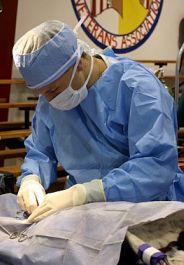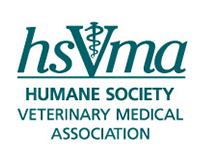HSVMA Highlights Animal Welfare-Friendly TrainingNovember 12, 2009 The Humane Society Veterinary Medical Association (HSVMA) sponsored a poster presentation entitled "Animal Welfare-Friendly Surgery Training" during the recent international symposium on animal welfare hosted by the American Veterinary Medical Association and the Association of American Veterinary Medical Colleges. The focus of the symposium, held at Michigan State University, was to discuss animal welfare in both veterinary medical education and research. Veterinary faculty, veterinary representatives from government and nonprofit agencies, animal scientists and veterinary students from throughout the United States and abroad attended. Is Humane Teaching Becoming the Norm? A veterinary student performs surgery during a HSVMA Field Services clinic. Windi Wojdak, RVT/HSVMA The poster, authored by HSVMA veterinary consultant Dr. Susan Krebsbach, highlighted veterinary surgical training methods used by various veterinary schools in the United States which involve only beneficial or neutral use of animals. There was positive feedback from both veterinarians and veterinary students on the poster, indicating that there is clearly support for a move to more humane training methods. Veterinary curricula have historically included harmful and terminal use of animals, but with growing ethical concerns, improved technology, and better collaboration with the animal protection community, these practices are being replaced by more humane training methods. Now, more than 50 percent of the veterinary schools in the United States have eliminated terminal surgeries from their core curricula. HSVMA Poster Highlights Various ModelsThe six different training methods highlighted in the HSVMA poster include:
In conjunction with the poster presentation, HSVMA distributed "Animal Welfare-Friendly Surgery Training," a handout that provides more supplemental material, including examples of each surgery training method, and "Surgery Basics", a general guide to spay/neuter procedures. |
